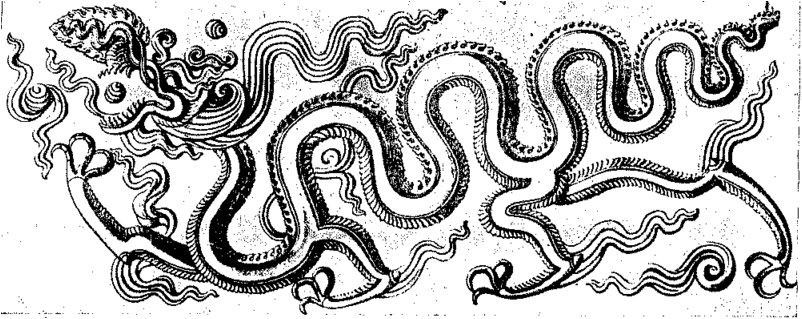It's just some thoughts I've gathered from here and there on the traditional mythological reptiles of Asia worth noting, comparing and contrasting them.
Let's start with the basic ones:
 The ever-familiar Tatsu or Ryu of Japan.
The ever-familiar Tatsu or Ryu of Japan.
Recognizable by its three toes, like most of the creatures we'll be mentioning, they are wingless and snake-like creatures with small clawed legs and a horned or antlered head.
These beings are associated with large bodies of water, the clouds in the skies or the heavens in general. The Ryu are often far more slender and fly less frequently than those in the traditions of Vietnam, Korea, or China.
It is connected to water and agriculture as bringers of rain and clouds. Many are said to reside in rivers, lakes, oceans or deep ponds inside mountains.
Politically, the Yong represents the Emperor. The Yong are usually depicted as benevolent. They possess a very specific number of scales: 81.
According to some sources, there's some numerology involved making the numbers 9 x 9 lucky and significant.

Featuring 4 or 5 toes and 118 scales, the Lung have several different variations including (but not limited to):
Tianlong (天龍) or Celestial Dragon.
Shenlong (神龍) or Spiritual Dragon, controller of the weather.
Fucanglong (伏藏龍) The Dragon of Hidden Treasures, guarding precious metals and jewels buried in the earth.
Dilong (地龍) Controlling rivers, Dilong is also considered the Earth Dragon. Dilong spends springtime in heaven and autumn in the sea.
Jiaolong (虯龍), the mighty Horned Dragon.
Panlong (蟠龍) is the term for the Coiling Dragon who dwells in the lakes of Asia.
My personal favorite is the Huanglong (黃龍)or Yellow Dragon - a hornless dragon regarded for its scholarly knowledge.
And then there are the four Dragon Kings (龍王) - each rules over one of the four seas.

Within Vietnamese tradition, there is a belief that they are the descendants of a Rồng who married a fairy.
This is interesting to me as we compare it to the stories the Lao tell about being descended from a giant Nak that lives in the Mekong River.

This is all quite a contrast from Judeo-Christian connections of the serpent to the expulsion from Paradise.

Just some interesting things to ponder for the night.
1 comment:
quite reminds me of a History channel (I think, though it may have been Discovery) show a 2-3 weeks ago: Satellite imagery has shown where Eden would have been, since the two missing rivers of the four-that-met-at-Eden are visible thataway. And it explained how a Neolithic human pair would find the catastrophic flooding of the valley there as literally the end of Eden. Thanks to the rise of oceanic levels due to melting at the end of the last Ice Age. . . ;D
But, one of the things they covered was the Judeo-Christian practice of taking things over for their own uses. Here, they played conquering-religion, and used the heroes and gods of the former religion as the bad guys (aka, the Serpent of the garden of Eden).
Interesting.
Fun stuff - keep it going!
C
Post a Comment